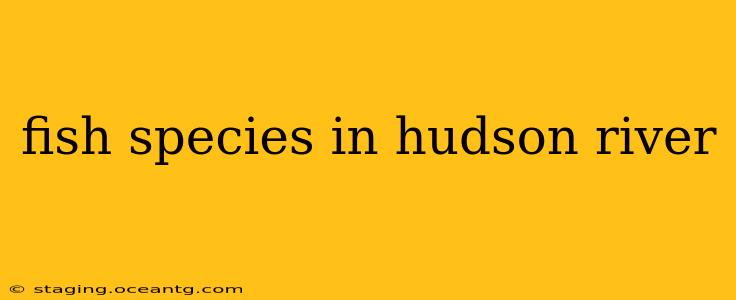The Hudson River, a majestic waterway flowing from the Adirondack Mountains to the Atlantic Ocean, boasts a surprisingly diverse ecosystem teeming with life, including a fascinating array of fish species. Understanding the fish population is crucial for managing this vital waterway and ensuring its continued health. This comprehensive guide explores the various fish species found in the Hudson, addressing common questions about their habitats, conservation efforts, and the overall biodiversity of this iconic river.
What types of fish are in the Hudson River?
The Hudson River's fish population is incredibly varied, ranging from anadromous species—those that migrate from saltwater to freshwater to spawn—to purely freshwater residents. Some of the most common and notable species include:
-
Striped Bass (Morone saxatilis): A highly prized game fish, striped bass are anadromous, traveling upstream to spawn. Their populations have fluctuated over the years, highlighting the importance of conservation efforts.
-
American Shad (Alosa sapidissima): Another anadromous species, American shad were once abundant but their numbers declined significantly. Restoration projects are underway to help recover their populations.
-
Alewife (Alosa pseudoharengus): These small, herring-like fish are also anadromous and play a crucial role in the Hudson's food web.
-
Hickory Shad (Alosa mediocris): Similar to alewives, hickory shad are also an important forage fish.
-
Blueback Herring (Alosa aestivalis): Another member of the herring family, blueback herring are a key part of the Hudson's ecosystem.
-
Atlantic Salmon (Salmo salar): While historically abundant, Atlantic salmon populations in the Hudson have been severely depleted. Reintroduction programs are actively working to bring this iconic species back.
-
White Perch (Morone americana): A common resident fish found throughout the river.
-
Brown Bullhead (Ameiurus nebulosus): A bottom-dwelling catfish species.
Beyond these, the Hudson supports a wealth of other species, including various sunfish, suckers, minnows, and other less-common fish. The exact composition varies by location within the river, influenced by factors like water salinity, temperature, and habitat availability.
Are there sharks in the Hudson River?
While the Hudson River is not typically associated with sharks, the occasional sighting of smaller shark species, particularly in the lower, more saline sections of the river near the ocean, is possible. These are typically smaller species that can tolerate brackish water, and their presence usually reflects their migration patterns rather than establishing a resident population. Think of these as rare visitors, not permanent residents.
What is the biggest fish in the Hudson River?
Determining the single biggest fish is difficult due to the lack of comprehensive, constantly updated data on fish size across the whole river. However, among the larger species frequently encountered in the Hudson, Striped Bass are strong contenders for the title, reaching impressive sizes. Other large species, while potentially reaching substantial size, are often less commonly encountered in the larger sizes.
What fish are endangered in the Hudson River?
Several fish species in the Hudson River are considered endangered or threatened, reflecting the impact of historical pollution and habitat degradation. Atlantic Salmon, while not technically extinct in the Hudson, is critically endangered, with reintroduction programs underway. The American Shad and other anadromous species have also experienced significant population declines, underlining the importance of ongoing conservation efforts.
What is the current state of the Hudson River fish population?
The current state of the Hudson River's fish population is complex and varies among species. While some species, such as white perch, are relatively abundant, others continue to face challenges. Ongoing monitoring programs, habitat restoration projects, and responsible fishing regulations are crucial in ensuring the long-term health and diversity of the Hudson's fish communities. The overall picture is one of recovery and resilience, but continuous effort is required to maintain progress.
How can I help protect the fish in the Hudson River?
Protecting the fish in the Hudson River requires a multi-faceted approach. Individual actions, such as practicing responsible fishing techniques (catch and release, respecting size and bag limits), reducing pollution, supporting organizations dedicated to river conservation, and advocating for effective environmental policies, all contribute to the health of this important ecosystem.
This exploration of the Hudson River's fish species provides a glimpse into the fascinating biodiversity and the ongoing efforts to conserve this valuable resource. The river's health and the future of its fish populations depend on informed stewardship and continued commitment to protection.
